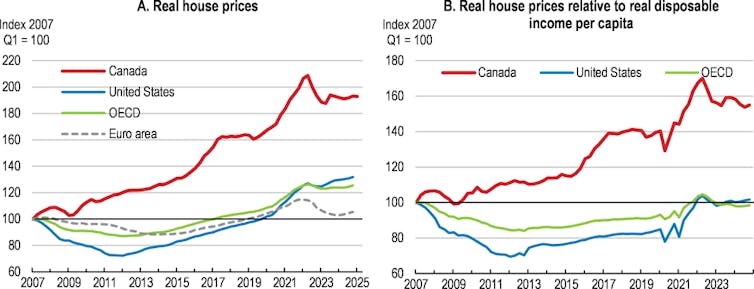Source: The Conversation – Canada – By Rachel Engler-Stringer, Professor, Department of Community Health and Epidemiology, University of Saskatchewan
This spring, as part of a sabbatical project, I had the privilege of visiting school food programs and meeting with school food researchers in six cities in France, England and Scotland.
I got to eat school lunches, visit central kitchens in two cities where meals are prepared for thousands of children, visit school kitchens and discuss school food with the countries’ leading experts.
This visit intersects with my research with colleagues on promising food programs across Canada. This research offers insights for consideration as regions navigate the federal government’s first National School Food Program and National School Food Policy.
Government announcements about the program and policy were followed by negotiations with the provinces and territories, all of which have since signed agreements for a portion of the funding.
In most parts of Canada, officials are just beginning to plan for new approaches to school food (with a few exceptions especially in Atlantic Canada where school food programs have been transforming much more quickly).
Based on my research about international food programs, here are four key things Canadians should pay attention to:
1) In Canada we need to shift from thinking of school lunches as a safety net for kids living in poverty to thinking about them as benefiting the health and well-being of children and their families. In France, this shift in thinking is particularly clear.
School lunches in France are about teaching children about food and culture and all kids are encouraged to eat together with an adult facilitator who teaches them about the components of the meal and creates a family-meal context at each table. By contrast, if you ask many parents in Canada what school meals are for, they will tell you they are for kids living in poverty to make sure they have food to eat at school.
If Canada wants a national school food program that achieves the benefits of the best programs in the world in the areas of education, well-being and on the economy, we need to think of school meals as supporting young people to be the best students they can be.
2) One important benefit of school food programs globally is to encourage picky eaters to try new foods due to the social pressure of all kids eating the same foods together. In three cities in France I visited, and one in England, school lunches look like home-cooked meals. One main dish with meat is served (and in England, a vegetarian alternative), and kids can choose if and how much of the side vegetables and fruit to take.
In Canada, following a similar practice — one main and a vegetarian alternative when meat is served — might work well. But it’s also important that in developing a menu, the cultural diversity of Canadian school communities is reflected in the food on offer.
In the other two locations in England and Scotland, kids choose from multiple main dishes — something that adds cost to the program and does less to encourage kids to try new foods, given one choice is always something basic like a cheese sandwich.
Kids need to have some autonomy when it comes to eating, but school food programs should not be facilitating eating the same food every day. Nor should school food programs aspire to a model where broad choice is afforded from a large menu.
3) With care, planning and sufficient resources, centralized kitchens can prepare thousands of servings of a main dish daily. The French central kitchens I visited prepare 6,000 to 10,000 servings a day of high-quality food following strict food safety protocols.
I ate two simple yet delicious meals cooked in municipally owned central kitchens. In the three cities in France where I visited, they used central kitchens where main dishes were prepared and chilled to be delivered for heating at the school level. Central kitchens also delivered the salads and sides (like chopped veggies, bread, cheese and fruit) and dressings.
In the small school kitchens, the salads were dressed, and the cheese and fruit were cut for service.
The central kitchens were also used in at least one city to prepare food for daycares and for seniors who were home-bound — something to consider for Canadian cities.
Centralizing kitchens can reduce costs and provide a way for high-quality food to be produced from basic ingredients without commercial kitchens in every school capable of preparing meals for hundreds of children at a time.
4) When designed with requirements for purchasing foods from local farmers and other Canadian producers, school food programs can benefit the agricultural sector and multiply their benefits to communities beyond direct school food jobs. In France, for example, there are specific percentages to be purchased from local and sustainable sources. Percentage requirements for local and sustainable purchasing should be enacted now in Canada as its program establishes itself, perhaps beginning with 20 per cent and growing over time.
I have many more reflections from my visits, both positive and negative, but the four I have discussed are important for Canada to learn from as it begins to design the National School Food Program to meet the needs of diverse communities from coast to coast to coast.
![]()
Rachel Engler-Stringer receives funding from the Canadian Institutes for Health Research, the Social Sciences and Humanities Research Council of Canada, the Public Health Agency of Canada and received a University of Saskatchewan International Travel Award for program visits. She sits on the Steering Committee of the Coalition for Healthy School Food.
– ref. School lunches, the French way: It’s not just about nutrition, but togetherness and ‘bon appetit’ – https://theconversation.com/school-lunches-the-french-way-its-not-just-about-nutrition-but-togetherness-and-bon-appetit-259832









